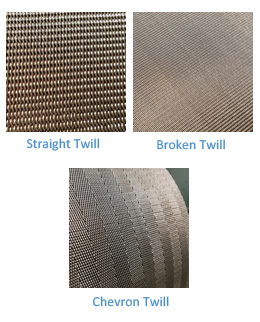

January 9 2018

In one of Parkinson Technologies’ previous articles, we discussed the use of reverse Dutch twill weave (RDW) filter belts used in ribbon-style continuous belt screen changers. We discussed the four basic types, how they differ, and how they evolved into the RDW style which offers the combination of strength and durability required for continuous belt screen changers. However, there are other factors to consider when choosing screen. The RDW weave pattern is one of them.
RDW is most commonly produced in three types of patterns: Straight Twill, Broken Twill, and Chevron Twill. Each of these patterns generally will have the same porosity for a given mesh size, but will have variations in the resulting torque that is applied to the screen. During the weaving process, pressure is applied to the wires increasing the torque in the screen, this additional torque will pull the screen to one direction or the other, introducing some skew. Skew in a screen ribbon could potentially cause problems in a continuous belt screen changer by binding and not allowing the screen to pass through freely. The difference between the weave patterns is as follows:
As you can see, the screen will behave differently depending on the weave pattern design. Choosing the right pattern is important for any melt filtration application. However, a high percentage of applications will often use the Broken Twill pattern which Parkinson Technologies readily stocks.
The weave pattern is not the only factor when choosing screen. In our next article, we’ll discuss mesh size and how pressure and the particles to be removed need to also be considered when selecting the correct size.